What is general information about the entry pass in basketball
The entry pass consists of action that occurs when an offensive player in possession of the ball throws it from the top/slot to the wing area and/or from a perimeter area of the court towards a post area, especially the low post area.
The primary types of entry passes are the wing entry pass and the post entry pass.
Essentially, when the ball gets thrown from the top to the wing, this is generally considered to be a wing entry pass.
Likewise, when the ball gets thrown from the perimeter, particularly the wing area, to the post area, this is often referred to as a post entry pass.
In addition to that, the wing entry pass is typically thrown beyond the three-point line and this mostly applies to the post entry pass as well.
However, in some instances, the post entry pass could also be thrown from the high post area to the low post area, specifically in the case of the high low pass.
Furthermore, the wing entry pass is commonly used to initiate a team’s half court set plays, quick hitters, or primary basketball offense strategy.
Nevertheless, it is still possible for a player to throw the wing entry pass at any particular time during offensive execution as opposed to being exclusively a first pass.
Moreover, upon receiving the ball via the wing entry pass, an offensive player could utilize the triple threat position to survey the court and read the defense.
Afterwards, that same offensive player could then proceed to execute a post entry pass if feasible or carry out some other type of basketball action such as a dribble move, jump shot, or pick and roll action.
The post entry pass is also a common element within various types of basketball offense systems.
Nonetheless, its main objective is to get the ball into the hands of an offensive player near a post area, which would normally be a power forward or a center as it relates to standard basketball positions.
Upon receiving the ball via the post entry pass, an offensive player could perform basketball actions such as a low post move (near the low post) or high low action (near the high post) as previously stated.
It should also be noted that the passing player within the post entry action should consider executing a fake pass before actually attempting to complete the post entry pass.
Essentially, the post entry passer should fake the ball high and then pass it low, specifically as a bounce pass, or fake the ball low and pass it high, particularly as an air pass.
The main purpose of the fake pass in this instance is to lower the chances of an on-ball defender deflecting or intercepting the ball, especially if that same defender implements at least a moderate amount of on-ball defensive pressure.
What are basic diagram examples of the entry pass
Basic Wing Entry
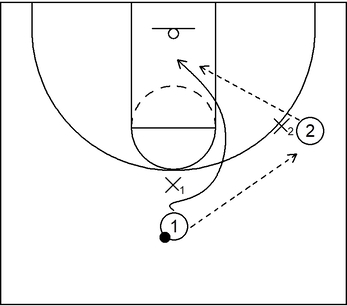
This is an example of a basic wing entry pass when the ball is initially at the top beyond the three-point line. To begin, 2 receives the ball near the right side wing by way of the wing entry pass from 1.
Following that, 1 executes a face cut to the basket, receives the ball again from 2, and scores at the rim. Also, as a side note, this sequence is known as give and go action or pass and cut action.
Basic Post Entry
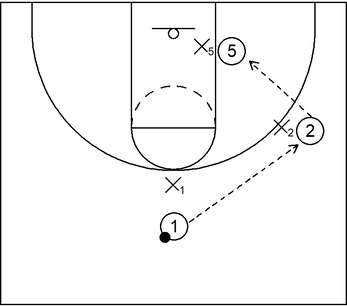
This is an example of a basic post entry pass, which also includes 1 at the top, 2 near the right side wing, and 5 near the right side low post block. To begin, 2 receives the ball via the wing entry pass from 1.
Next, 5 receives the post entry pass from 2 and after that, 5 could attempt to score by way of a low post move.
Dribble Entry to Post Entry

This is an example of a very simple basketball play that consists of a dribble entry and a post entry pass. To start, 1 is initially in the left slot and then dribbles toward the left side wing, which is also the dribble entry action.
Next, 5 cuts across the lane to the left side low post area via the cross screen set by 2, who also empties out to the right side corner following the screening action.
After that, 5 receives the ball via the post entry pass from 1. During the last part of the simple play, 5 could attempt to score around the rim via a low post move such as the drop step.
Basic High Low
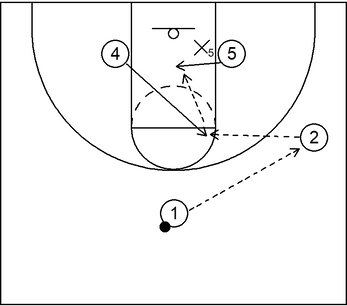
This is an example of basic high low action, which also features 1 at the top, 2 on the right side wing, 4 near the left side low post area, and 5 near the right side low post area.
To start, 2 receives the ball via the wing entry pass from 1. Next, 4 executes a flash cut to the right side high post elbow area and receives the ball from 2, which would also be a high post entry pass.
Following that, 5 could duck in and seal the defender under the basket, receive the ball from 4 via the high low pass (this would also be a post entry pass as well), and score around the basket, particularly with a low post move such as a hook shot.
Laker Cut
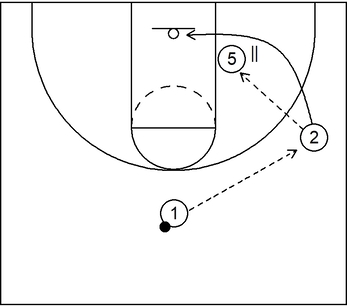
This is an example of basic post entry action in addition to a Laker cut for a scoring opportunity at the rim. To begin, 2 receives the ball by way of the wing entry pass from 1.
Next, 5 receives the ball via the post entry pass from 2. Afterwards, 2 executes a Laker cut on the low side, receives the ball from 5 via a handoff, and scores at the basket with a layup or dunk.
Princeton Chin
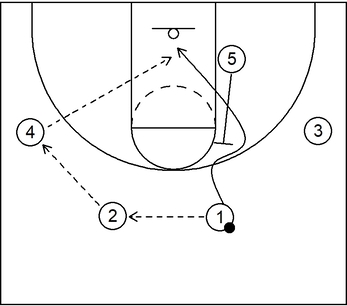
This is an example of basic action within the Chin series of the Princeton offense, which includes a slot to slot pass followed by a wing entry pass. To begin, 2 receives the ball from 1, which is the slot to slot pass.
Next, 4 receives the ball from 2, which is the wing entry pass. Also, as a side note, for this example, the wing entry pass is initiated from the slot as opposed to the middle third of the court, which is the area at the top that is between the slots.
From there, 1 cuts to the basket via the back screen set by 5. Afterwards, 1 could receive the ball from 4 and score by way of a layup or dunk.
Triangle Solo

This is an example of the solo series within the triangle offense, which features a two-man game on the strong side of the court with a sideline triangle on the weak side.
In terms of the initial setup, 1 begins near the left slot area, 2 begins in the opposite right slot, 3 begins near the left side wing, 4 begins near the right side short corner, and 5 begins near the left side low post block.
To start the action, 3 receives the ball from 1, which is also the wing entry pass. Next, 1 executes a solo cut towards the right side corner and 1 also receives a rub screen from 4.
As that happens, 5 receives the ball from 3, which is also the post entry pass. Afterwards, 4 cuts into the lane by way of a cross screen set by 3 at the same time.
Following that, 4 receives the ball from 5 and could score via a layup or dunk while 2 cuts away to the right side wing.